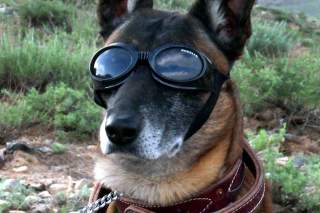The U.S. Army Had Secret War Dogs in Vietnam
Really.
In 1966, the U.S. Army trained sniffer dogs and their human companions to track down guerrillas in Vietnam. The military kept these Combat Tracker Teams secret to hide them from the enemy—and shield reluctant allies from a potential international incident.
The impetus for the canine teams came from frustrated American commanders. The Viet Cong were masters of terrain, camouflage and tunneling—and dictated when and where a fight happened. More importantly, the enemy fighters could decide how long a battle lasted.
“The U.S. command in Saigon [wants] to solve the problem of re-establishing and maintaining contact with enemy forces after they have broken contact with U.S. units,” stated a report by the Army’s private Combat Operations Research Group.
While the Army used scout dogs in World War II and Korea, the new Combat Tracker Teams were different. Instead of just watching for enemy troops, the canines and their handlers would actively chase them down.
In doing so, the soldiers could point friendly troops in the right direction, or help call in artillery and air strikes.
“It was not so much the team that did the engaging, but they would be accompanied by a conventional unit,” says former Special Forces soldier and military historian Gordon Rottman.
The Army’s first problem was a lack of tracking experience. A previous experiment with bloodhounds failed because the dogs made such a ruckus as they followed the scent, according to the CORG review.
The British Army already used Labrador retrievers—who moved far more quietly—to find ethnic Chinese insurgents in Malaysia and Indonesian guerrillas in Borneo. But asking the British for help created a whole new set of issues. Unlike Washington, London signed the 1954 Geneva Accords that partitioned Vietnam in two … and required foreign forces to leave.
This agreement made British authorities lukewarm to the expanding conflict in southeast Asia. If they openly participated, the Soviet Union or the People’s Republic of China might accuse them of violating the spirit of the accords.
Complicating matters further, the British Jungle Warfare School was inside Malaysia. Like Britain, Kuala Lumpur took a neutral stance on Vietnam.
But the three countries eventually agreed to train 14 tracker teams at the British Army’s school in Johor Bahru. The U.S. Army would later establish its own course somewhere in the United States.
A five-man element with two retrievers became the basic building block of these British-trained teams. A reserve of extra animals made sure missions weren’t interrupted because of illnesses or wounds.
In addition, a visual tracker accompanied the troops and their dogs. These perceptive—and uniquely qualified—soldiers could discern details about the enemy just from footprints and disturbed foliage.
“Granted, dogs can follow a person anywhere, but the visual tracker can determine numbers, if they’re more heavily loaded, whether they’re moving fast or slow, detect dropped [or] discarded items etc.,” Rottman explains.
“A well experienced visual tracker is able to tell the sex of the people making the track and the type of weapons that they are carrying,” the report claims.
But the teams couldn’t do everything. Trackers couldn’t verify their findings in the dark, and heavy rains made picking up the enemy’s trail impossible, according to an undated overview found in the National Archives at College Park, Maryland.
And they couldn’t do much beyond defend themselves if they did find insurgents. Armed only with rifles, the units relied on larger forces to launch attacks.
Army officials quickly doled out the new Combat Tracker Teams to infantry divisions, brigades and the 11th Armored Cavalry Regiment in South Vietnam.
Still, secrecy pervaded the early stages of the program.
“The … teams had more significant capabilities [than] scout dogs and they did not want that known, but the main reason was because of Commonwealth involvement and that they were trained in Malaysia,” Rottman notes.
In the end, troops from the United Kingdom, Malaysia, Australia and New Zealand ran the training program for American soldiers. Both Australia and New Zealand had troops fighting in South Vietnam.
Two years after the project started, the U.S. finally began training the trackers at Fort Gordon in Georgia. The Army came up with its own organization, trimming one dog and its handler from each element. The ground combat branch also attached Viet Cong defectors—known as Kit Carson Scouts—to the tracking units.
With this new American flavor, the Combat Tracker Teams received official monikers. Formations assigned to divisions became infantry platoons, while those in smaller units became infantry detachments.
The Army also retroactively applied these changes to existing unit histories, no doubt making authorities in the United Kingdom and Malaysia quite happy.
References to foreign trainers and the British Jungle Warfare School are crossed out in archival document, reproduced above. In the margin, someone has written “at Fort Gordon, GA” as the suggested replacement. Descriptions of the original, British-style unit organization are likewise marked over in the paper.
But the teams still had trouble finding their elusive opponents. Between September 1969 and January 1971, the 63rd Infantry Platoon only detained some 80 suspected insurgents, according to periodic reports kept in the National Archives.
The platoon went entire months without seeing guerrilla forces, despite discovering enemy tunnels, caves, booby traps and mines, the monthly updates note.
After the end of the conflict in Vietnam, the Army disbanded the tracker units. In 1973, the ground combat branch drew up a single, consolidated organizational document detailing the requirements for all sorts of special dog teams.
But the ground combat branch would only recreate these formations “as required,” according to the document, which we obtained via the Freedom of Information Act.
These troops and their dogs are required again. In places like Iraq and Afghanistan, canine teams made a comeback, sniffing for insurgents and roadside bombs.
This article originally appeared at War is Boring in 2015.
Image: Flickr.

